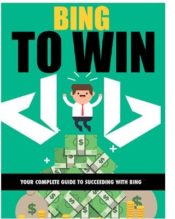Bing to Win: Bing Marketing 101

Bing to Win: Bing Marketing 101
Bing is the second most important search engine in the world. While it is true that it is not as large as Google and its ad network is not as large, it is also true that it still offers a considerable marketing opportunity for those who learn how to use it.
In this Bing to win course, you will discover why Bing can be such a powerful marketing tool in relation to both free and paid promotional opportunities. Learning how to create content that the search engines will love is the best way to get free traffic. Learning how to use the Bing Ads network is the best way to test new marketing initiatives and discover what keywords are worth trying to score well with in the search engine results pages (SERPs) and in Pay Per Click (PPC).
If you are eager to get more targeted and qualified traffic to your site in an economical way, Bing could be the winning solution you’re looking for.
To Order This Course:
Click on the button on the right, BUY NOW, to pay for the course. You will be asked to create a user name and password for this site. Once you have set up your free account, you buy any course on the site. Pay via PayPal or any credit card.
Once you have paid, return to this course page. Instead of the BUY NOW button, you will see a Start the Course button instead. Click on it to start studying now.
Note: You may have to REFRESH the page for it to update.
Introduction
Bing is often neglected due to the popularity of Google. Bing Ads are often neglected due to the popularity of the Google AdWords system. While Google can get great results when it comes to marketing your business, it is not that easy to rank well, and in terms of the ads, can also cost you significantly more than any other online ad network.
Bing is less expensive, and can also help you to tap into certain markets who lean towards Microsoft products in general, and Bing as a search engine and ad network in particular.
The right SEO, Search Engine Optimization, and the right PPC (Pay Per Click) strategy, can do wonderful things for your business and send a huge amount of targeted traffic to your website. This is a method you can use to bring in new customers that are effectively qualified leads. That means that they have already demonstrated an interest in your product and are actively looking to buy it at the time they arrive on your site.
In other words, if you create content about hats, the search engine will know what your site is all about. If you use a PPC campaign and place your ads on Google searches for ‘Buy hats online’, then you’re going to get visitors who want to buy your hats! Unlike search optimization, there’s no waiting here and no element of luck. As soon as you start paying, your audience will start clicking on your ads when they perform that search and you will start making sales. And you’ll pay precisely the amount that you are willing to pay, practically guaranteeing strong return on investment (ROI) for your campaign.
But this doesn’t always work. If it was that easy, then everyone would be earning a fortune through AdWords. The problem is that there’s just too much competition, which means you need to be much smarter about your approach.
And guess what one of the best strategies you can possibly use is? Placing ads with Bing instead of Google!
Surprised? Read on and we will explain why this is the perfect strategy.
Building a Great PPC Campaign
Let’s start with the basics of what goes into building a great Pay Per Click (PPC) campaign. The key is to not try to be all things to all people, and to target the right people to click on your ads.
An effective PPC campaign needs to be precise and you have to know your numbers, that is, profits versus what the campaign is costing you. If you do both those things right, then there’s no way that you can fail to get results.
So how do you go about this?
For starters, let’s very quickly recap on PPC. PPC means Pay Per Click, which of course means you are paying for clicks. That means you don’t pay if someone doesn’t look at or interact with your ad.
This is good news because a click means a visitor, and that means you now know precisely how much your visitors are costing you when you run an ad, as compared with getting free traffic, also referred to as organic traffic, through other marketing methods.
The next step then is to work out how much your visitors are worth to you. You can do this by doing some quick math. Calculate how many visitors you have a day and how many products you sell a day. Then calculate how much profit you make on each of those products.
So if you have an ebook worth $50 and you sell one of those every two days, then 1,000 visitors a day means you make $100 for every 2,000 hits. Thus each visitor is worth 0.025cents to you right now. You can increase this by increasing the cost of your book, or by improving your conversion rate, that is, getting more people to buy.
The higher you can get your conversion rate, the better your campaign will be. The average is 1% online. If you could boost it to 3% to 5%, what difference would that make to your level of profits?
Once you have this number, you have an amount you can pay for guaranteed profits. If you make 10 cents per visitor, then you can pay up to 9 cents per click and come away with almost guaranteed money in the bank at the end of a campaign. Of course, it would be even better if you could improve on these margins, so testing, tracking and fine tuning your campaigns is a must.


